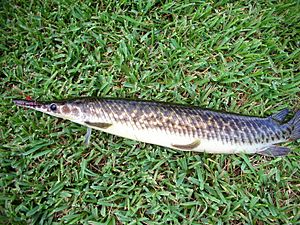Florida gar facts for kids
Quick facts for kids Florida gar |
|
|---|---|
 |
|
| Conservation status | |
| Scientific classification | |
| Synonyms | |
|
The Florida gar (Lepisosteus platyrhincus) is a cool type of gar fish. You can find them in the southeastern United States. They live in places like the Savannah River and Ochlockonee River areas. They are also found all over Florida.
Florida gars can grow quite long, sometimes over 3 feet (91 cm)! Young gars eat tiny water creatures called zooplankton. They also munch on insect larvae and small fish. Adult gars mostly enjoy eating bigger fish, shrimp, and crayfish. Even though you can eat them, most people don't. But be careful! Their roe (eggs) are very poisonous to many animals, including people and birds.
Contents
What Does the Florida Gar Look Like?
The Florida gar is a medium-sized fish. It usually grows to be about 20 to 52 inches (51.7 to 132.2 cm) long. These fish typically weigh between 3 and 9.6 pounds (1.36 to 4.36 kg). The biggest Florida gar ever caught weighed about 22 pounds (10 kg)!
This fish has cool black spots. You can see them on top of its head and all over its body. Even its anal fin has these spots. Its snout is shorter and wide. It has a single row of sharp, uneven teeth on both its upper and lower jaws.
The distance between its eyes is less than two-thirds the length of its snout. Also, it doesn't have bony scales on its throat. Their back and upper sides are olive-brown. Their belly is white or yellow. Young gars might have dark stripes on their back and sides.
Where Do Florida Gars Live?
Florida gars live in the Ochlocknee River and other waters in Florida. They like medium to large streams, canals, and lakes. These places usually have muddy or sandy bottoms. They prefer areas with lots of underwater plants.
You can often find them in water that is not too deep. They have a special air bladder. This helps them breathe air from the surface. This is super helpful when the water doesn't have much oxygen. They sometimes hide in weeds that are 4 to 10 feet deep. Often, their head is in the weeds, with just a small part of their body showing. They might also hide at the edge of weeds. Here, they are usually about 6 to 10 inches below the surface. The bottom in these spots is often 10 feet or deeper.
Florida Gar Life Cycle
Florida gars lay their eggs in late winter and early spring. This usually happens between February and March. Groups of male and female gars come together. They meet in shallow water where there are lots of weeds. The female gars release their sticky eggs among the water plants. Many males usually fertilize the female's eggs.
When the young gars hatch, they have a special sticky organ on their snout. They use this to attach themselves to plants. They stay attached until they are about 0.8 inches (2 cm) long. After spawning, male gars become less active in reproduction during the summer.
Cool Facts About Florida Gar Behavior
During the dry season, Florida gars have a neat trick. They can burrow into the mud at the bottom of marshes. Then, they go into a special sleep called aestivation. This is a bit like hibernation for other animals. Aestivation slows down their body's activities. This helps the Florida gar survive when it's very hot and dry.
What Do Florida Gars Eat?
Adult Florida gars are ambush predators. This means they hide and wait for their prey. They sneak up on their food. Then, they use a quick side lunge of their long heads to strike and catch it. These strikes are super fast! They usually last only about 25 to 40 milliseconds.
Once they catch their prey, the gar shakes its head from side to side. This helps them get the prey into the right position. Then, they swallow it head first. Adult Florida gars mostly eat fish, shrimp, and crayfish. Younger gars eat tiny water creatures called zooplankton and insect larvae.



